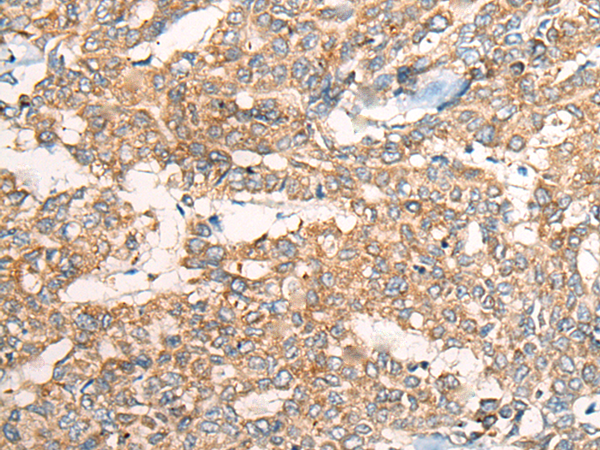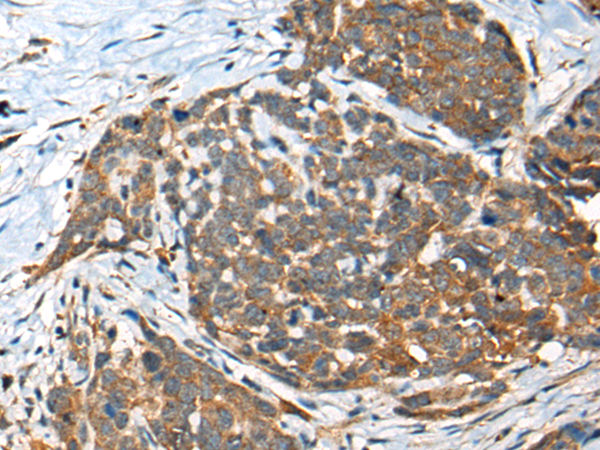

| WB | 咨询技术 | Human,Mouse,Rat |
| IF | 咨询技术 | Human,Mouse,Rat |
| IHC | 1/25-1/100 | Human,Mouse,Rat |
| ICC | 技术咨询 | Human,Mouse,Rat |
| FCM | 咨询技术 | Human,Mouse,Rat |
| Elisa | 1/5000-1/10000 | Human,Mouse,Rat |
| Aliases | TX; Mih1; ICH-2; Mih1/TX; ICEREL-II; ICE(rel)II |
| Host/Isotype | Rabbit IgG |
| Antibody Type | Primary antibody |
| Storage | Store at 4°C short term. Aliquot and store at -20°C long term. Avoid freeze/thaw cycles. |
| Species Reactivity | Human |
| Immunogen | Synthetic peptide of human CASP4 |
| Formulation | Purified antibody in PBS with 0.05% sodium azide and 50% glycerol. |
+ +
以下是关于CASP4(Caspase-4)抗体的3篇代表性文献,包含文献名称、作者及摘要概括:
---
1. **文献名称**:*Caspase-4 is required for activation of inflammasomes in response to cytoplasmic LPS*
**作者**:Casson CN, et al.
**摘要**:该研究通过Western blot和免疫荧光技术,使用CASP4抗体证实了CASP4在识别胞内脂多糖(LPS)中的关键作用。研究发现,CASP4通过与炎症小体组分相互作用,促进IL-1β的成熟释放,揭示了其在革兰氏阴性菌感染中的免疫调控机制。
---
2. **文献名称**:*Non-canonical inflammasome activation targets caspase-11 in Alzheimer's disease*
**作者**:Lee HM, et al.
**摘要**:本文利用CASP4特异性抗体,在阿尔茨海默病模型中发现β淀粉样蛋白激活CASP4.触发神经炎症反应。研究通过免疫组化显示CASP4在患者脑组织中的高表达,并证明其通过切割Gasdermin D介导神经元焦亡。
---
3. **文献名称**:*Caspase-4 mediates non-canonical activation of the NLRP3 inflammasome in human myeloid cells*
**作者**:Baker PJ, et al.
**摘要**:该研究通过siRNA敲低结合CASP4抗体验证,阐明CASP4在人类巨噬细胞中通过非经典途径激活NLRP3炎症小体。实验表明,CASP4抗体可阻断内质网应激诱导的IL-18分泌,提示其作为潜在抗炎治疗靶点。
---
**备注**:CASP4抗体在上述研究中主要用于检测蛋白表达(Western blot)、定位(免疫荧光/组化)及功能验证(如阻断实验)。研究聚焦于其在感染、神经退行性疾病及炎症小体激活中的机制。如需具体DOI或发表年份,可进一步补充检索。
The CASP4 antibody is designed to detect caspase-4. a cysteine-aspartic protease involved in inflammatory and apoptotic pathways. Caspase-4. also known as caspase-11 in mice, is part of the inflammatory caspase subfamily and plays a critical role in innate immunity. It is structurally characterized by a C-terminal catalytic domain and an N-terminal caspase activation and recruitment domain (CARD), which facilitates interactions with other signaling molecules.
CASP4 is primarily activated in response to intracellular pathogens or danger signals, such as cytosolic lipopolysaccharides (LPS). Upon activation, it cleaves gasdermin D (GSDMD) to induce pyroptosis, a pro-inflammatory cell death, and promotes the maturation of interleukin-1β (IL-1β) and IL-18 via the non-canonical inflammasome pathway. Dysregulation of CASP4 has been linked to sepsis, autoimmune disorders, and neurodegenerative diseases.
Antibodies targeting CASP4 are essential tools for studying its expression, activation (e.g., detection of cleaved fragments), and subcellular localization in experimental models. They are widely used in techniques like Western blotting, immunofluorescence, and flow cytometry. Research involving CASP4 antibodies has advanced understanding of its role in pathogen defense and inflammatory pathologies, highlighting its potential as a therapeutic target for conditions driven by excessive inflammation.
×